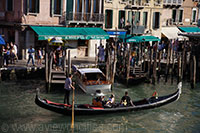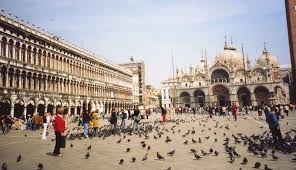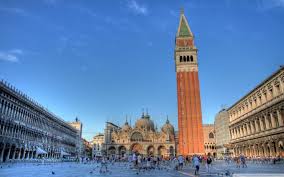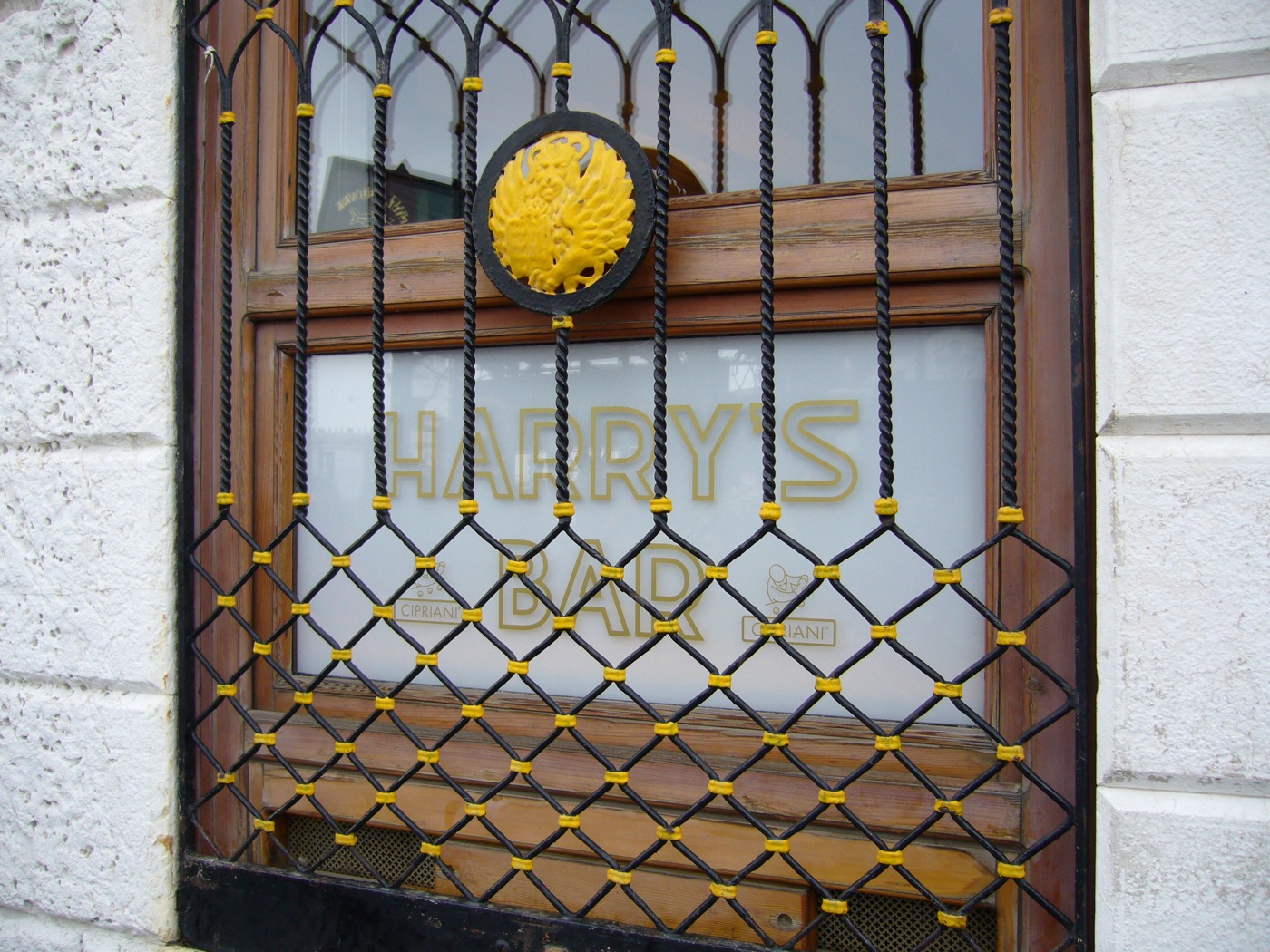"I will never forget experiencing Venice for the first time. It feels like you are transported to another time - the art, music, food and pure romance in the air is like no other place."
Elizabeth Berkley
"Venice is like eating an entire box of chocolate liqueurs in one go."
Truman Capote
 |
| Venice |
Today is my husband and my 46th wedding anniversary. Seems like just yesterday, sometimes. The reason I mention our anniversary, is because we visited Italy to celebrate our 25th anniversary and plan to go back to Italy in 2017 to celebrate our 50th. One of my favorite places when we visited on that trip, was Venice. There was just something about the atmosphere of the city that I loved. Maybe it is all that water, since I am definitely a water person. Or maybe it was all the colorful crumbling palazzos that line the Grand Canal, which I found to be charming and added such character to the place. Or maybe it was St. Mark's Square or Harry's Bar, which I loved. Whatever the reason, I plan to make it a definite stop on our return trip.
 |
Some of the crumbling walls of Venice
I loved the textures and the atmosphere. |
Venice is a city in northern Italy, the capital of the region Veneto and is world famous for its canals. It is made up of 118 islands formed by approximately 150 canals in a shallow lagoon. The islands are connect by around 400 bridges. Transportation within the city is by foot or by water. It is considered by many to be one of the most beautiful cities in the world. The classical Venetian boat is the gondola, although now it is mostly used by tourists. Most Venetians now travel by motorized waterbuses known as vaporetti.
If you go to Venice you will arrive on the mainland and will probably take a water bus over to the old city. You will cross the Grand Canal, which is the main waterway of the city, to do this. There are many things to see and do while visiting this city. Below is my list of things.
 |
| Gondola on the Grand Canal |
The Grand Canal is an ancient waterway, lined with buildings that were mostly built from the 13th to the 18th centuries. It forms one of the major water-traffic corridors in the city. The two mile trip from the railway station on the mainland to St. Marks Square provides a suberb introduction to the city. Public transport is provided by water buses (vaporetto) and private water taxis, and many tourists explore the canal by gondola. Whatever form of public transportation you decide on, make sure you tour the Grand Canal.
The glorious past of Venice returns once a year to the Grand Canal during the Regata Storica (historical regatta) on the first Sunday of September. The first of these regattas - boat races - were held in the 14th century. The races are proceeded by a spectacular boat parade, led by the Serenissima, a sumptuously decorated boat.
 |
| St. Mark's Square and the famous pigeons |
Piazza San Marco (Saint Mark's Square), is the principal public square of Venice, where it is generally known just as "the Piazza". A remark usually attributed to Napoleon calls the Piazza San Marco "the drawing room of Europe." It is one of the few remaining great urban spaces in Europe where human voices prevail over the sounds or motorized traffic. The Piazza is dominated at its eastern end by the Basilica of Saint Mark. Towering over the square is the Campanile, which is the bell tower for the church. It is famous for it massive amounts of pigeons. At night there are cafes where you can eat or just have a drink and listen to the music. The piazza is a great place to stroll around and do some people-watching.
 |
| Basilica St. Mark |
The Cathedral Basilica of Saint Mark is the cathedral church of the Roman Catholic Archdiocese of Venice. It is the most famous of the city's churches and one of the best known examples of Byzantine architecture. It lies at the eastern end of Saint Mark's Square, adjacent and connected to the Doge's Palace. The church is beautiful and well worth a visit, but make sure you dress appropriately, no shorts or bare shoulders even for children - you will be turned away if you ignore the rules.
The Doge's Palace is a palace built in Venetian Gothic style, and one of the main landmarks of the city of Venice. The palace was the residence of the Doges of Venice. A Doge is the elected-for-life Duke, the supreme authority of the Republic of Venice. This was the most powerful half-acre in Europe for 400 years. It was built to show off the power and wealth of Venice, and to remind all visitors that Venice was number one. It opened as a museum in 1923. You can now tour the palace and see how the Doge's lived. The tour includes the Bridge of Sighs and the prison.
 |
| The Campanile is St. Mark's Square |
The Campanile is the bell tower of Saint Mark's Basilica. It stands separate from the church in St. Mark's Square. It is the highest structure in the city, offering a pigeon's-eye view that includes the lagoon, its neighboring islands, and the red rooftops and church domes and bell towers of Venice -- and, oddly, not a single canal. On a clear day, you may even see the outline of the distant snowcapped Dolomite Mountains. You can ride the elevator 318 feet to the top for the best view in Venice. For an ear-shattering experience, be on top when the bells ring.
 |
| Rialto Bridge at night |
The Rialto Bridge is one of the four bridges spanning the Grand Canal in Venice. It is the oldest bridge across the canal, and was the dividing line for the districts of San Marco and San Polo.
The Rialto Bridge is an elegant, arched stone bridge lined with arcades on each side. The central archway at its pinnacle, accessed via the wide stairs that rise from either side of the bridge, serves as a lookout perch. Under the arcades are numerous shops, many of which cater to the tourists who flock here to see this famous bridge and its views of the gondola-filled waterway of the Grand Canal.
 |
| Bridge of Sighs |
The Bridge of Sighs is a bridge located in which is actually part of the Doge Palace. The enclosed bridge is made of white limestone and has windows with stone bars. It passes over the Rio di Palazzo and connects the New Prison to the interrogation rooms in the Doge's Palace. It was built in 1602, and was the last view of Venice that convicts saw before their imprisonment. The bridge name, given by the poet Lord Byron in the 19th century, comes from the suggestion that prisoners would sigh at their final view of beautiful Venice through the window before being taken down to their cells. In reality, the days of inquisitions and summary executions were over by the time the bridge was built and the cells under the palace roof were occupied mostly by small-time criminals. In addition, little could be seen from inside the Bridge due to the stone grills covering the windows.
A local legend says that lovers will be granted eternal love if they kiss on a gondola at sunset under the bridge as the bells of St. Mark's Campanile toll.
 |
| Murano |
Murano is a series of islands linked by bridges in the Venetian Lagoon. It lies about north of Venice and has a population of just over 5,000. It is famous for its glassmaking. This Venetian island has been world-renowned for centuries for its blown glass creations, from jewelry to tableware to sculptures. Visits here often include a tour of one of its fascinating glass factories, demonstrations of how it’s done—and of course, a visit to at least one of the affiliated showrooms and shops. You can get to the island on your own by taking a water taxi, or you can sign up for a tour which will take you to the glass factory for a demonstration. Be prepared to also be taken to a showroom, for purchases. We came home with some beautiful Venetian glass, which was expensive, but will become a family heirloom.
Lido de Venezia - The Lido is an island located in Venice, home to about 20,000 residents. The Venice Film Festival takes place at the Lido every September. The Lido di Venezia is one of the Venetians’ favorite destinations during summer time. Its beaches are extremely charming and elegant, the seabed forms a gentle slope that allows even the smallest children to bathe safely. There are many establishments that will rent you a hut for the day, or a chaise lounge to enjoy your day of relaxing by the water.
 |
| Picture I took while wandering across bridges and down alleyways |
So those are the main sights to see while in Venice. But don't get to hung up on the sights. Yes, you should see those things, but the main thing about Venice is the atmosphere of the place. Take time to wander aimlessly about the alleys and across bridges, into the side-streets. See where the people live. Get lost. We did our second day there, and it was the best part of our visit. We wandered through little courtyards, watched people hanging their clothes on the lines, and had some gelato. We got a feel for what it would be like to live there.
 |
| Gondola |
And take a gondola ride. Yes, its touristy, but its worth it. Go under the Bridge of Sighs and if you are with someone you love, than kiss under the bridge - why not! Take a tour of the Grand Canal, either by gondola, or by water taxi.
Enjoy the local cuisine, have a glass of wine. Enjoy the atmosphere of dining in Saint Mark's Square and listening to the orchestras play. Watch the people, other tourists like yourself and the locals. And you just have to try the gelato while anywhere in Italy. I have been told that the best gelato in Venice is at the Boutique del Gelato, a tiny outlet on busy salizzada San Lio. Be prepared to be patient though, I'm also told there is usually a line.
Shop for a few souvenirs to take home, or gifts for those loved ones. Venice is famous tor its Venetian glass, for wonderful Carnivale masks, and for its lace and its jewelery. When we were there I bought our daughter a wonderful Carnivale mask which was made of plaster and had lace on it. It is beautiful, and she has it mounted on a wall in her home.
My last suggestion may not be valid anymore. I would have said to go and have a Bellini (a drink made of white peach juice and Prosecco) at Harry's Bar. I would have also suggested dinner there. However, I understand that Harry's Bar in Venice is having financial troubles and it undergoing some management changes. The ratings on it have dropped, and it may even close, which would be a shame. It is an institution in Venice and has such an interesting story. I loved the bar when we were there before, and if it is still around when we return, I will certainly visit it. I do remember that we had a horrible time finding it. It is just off St. Mark's Square, but it does not have signs above its door. The only signage is a side window. We probably walked past it several times before a local pointed it out to us. I have posted the story of Harry's Bar below.
History of Harry's Bar 
Giuseppe Cipriani may never have had his own bar if he had not met a 'sad' young American, Harry Pickering.
And even if he had somehow got the money, it certainly would have been called something else. While working as a barman at Hotel Europa in Venice, Cipriani struck up a friendship with Pickering, a student who was staying in Europe with his aunt.
After she left him alone in a foreign country with no money, Cipriani offered to lend his new friend, who he called 'such a fine young man', 10,000 lira so that he could return home. He was not at all sure he would ever see the money again.
Two years later, after he had given up hope, Pickering walked in and said thanks for the money and gave him back his original 10,000 lira plus 40,000 lira so he could open his own bar.
Cipriani recalled his friend saying: 'I think they'll call it Harry's Bar. Not a bad name.'
He rented a nearby warehouse and transformed it into one of the most chic bars in town. He had many famous patrons, including Charlie Chaplin, Ernest Hemingway, Truman Capote, Orson Wells, Barbara Hutton and many more.







No comments:
Post a Comment